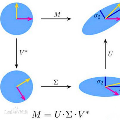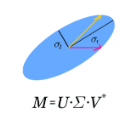Current dense symmetric eigenvalue (EIG) and singular value decomposition (SVD) implementations may suffer from the lack of concurrency during the tridiagonal and bidiagonal reductions, respectively. This performance bottleneck is typical for the two-sided transformations due to the Level-2 BLAS memory-bound calls. Therefore, the current state-of-the-art EIG and SVD implementations may achieve only a small fraction of the system's sustained peak performance. The QR-based Dynamically Weighted Halley (QDWH) algorithm may be used as a pre-processing step toward the EIG and SVD solvers, while mitigating the aforementioned bottleneck. QDWH-EIG and QDWH-SVD expose more parallelism, while relying on compute-bound matrix operations. Both run closer to the sustained peak performance of the system, but at the expense of performing more FLOPS than the standard EIG and SVD algorithms. In this paper, we introduce a new QDWH-based solver for computing the partial spectrum for EIG (QDWHpartial-EIG) and SVD (QDWHpartial-SVD) problems. By optimizing the rational function underlying the algorithms only in the desired part of the spectrum, QDWHpartial-EIG and QDWHpartial-SVD algorithms efficiently compute a fraction (say 1-20%) of the corresponding spectrum. We develop high-performance implementations of QDWHpartial-EIG and QDWHpartial-SVD on distributed-memory anymore systems and demonstrate their numerical robustness. Experimental results using up to 36K MPI processes show performance speedups for QDWHpartial-SVD up to 6X and 2X against PDGESVD from ScaLAPACK and KSVD, respectively. QDWHpartial-EIG outperforms PDSYEVD from ScaLAPACK up to 3.5X but remains slower compared to ELPA. QDWHpartial-EIG achieves, however, a better occupancy of the underlying hardware by extracting higher sustained peak performance than ELPA, which is critical moving forward with accelerator-based supercomputers.
翻译:因此,当前最先进的 EIG 和 SVD 执行可能只达到系统持续高峰性能的一小部分。基于 QR 的快速智能 Halley (QDWH) 算法可能因在三对角和角角降级期间缺乏峰值而受到影响。这种性能瓶颈是双向转变的典型,因为BLAS 的记忆调用。因此,目前最先进的 EIG 和SVD 执行程序可能只达到系统持续高峰性能的一小部分。 以 QR 为基础的快速智能 Halley (QDWH) 算法可能被用作向 EIG 和SVD 解算法的预处理步骤,同时减轻上述的瓶落。 QH-E-EG 和Q-S Oq 的快速性能变化,通过S-Creial-D 递进化的S-SD QQ(SHIGQ) 和S-S-S-S-S-SQ 的高级性平级平级计算,只能通过S-S-S-S-S-S-SQ-SQ 的高级智能化的高级智能化的高级智能运行运行运行,显示S-S-S-S-Q(S-S-S-S-S-S-S-S-S-S-SQ) 的S-S-S-S-S-S-SQ-SQ 的升级的高级性性性性性能性能性能性能性能性能性能性能性能性能性能性能的升级)


